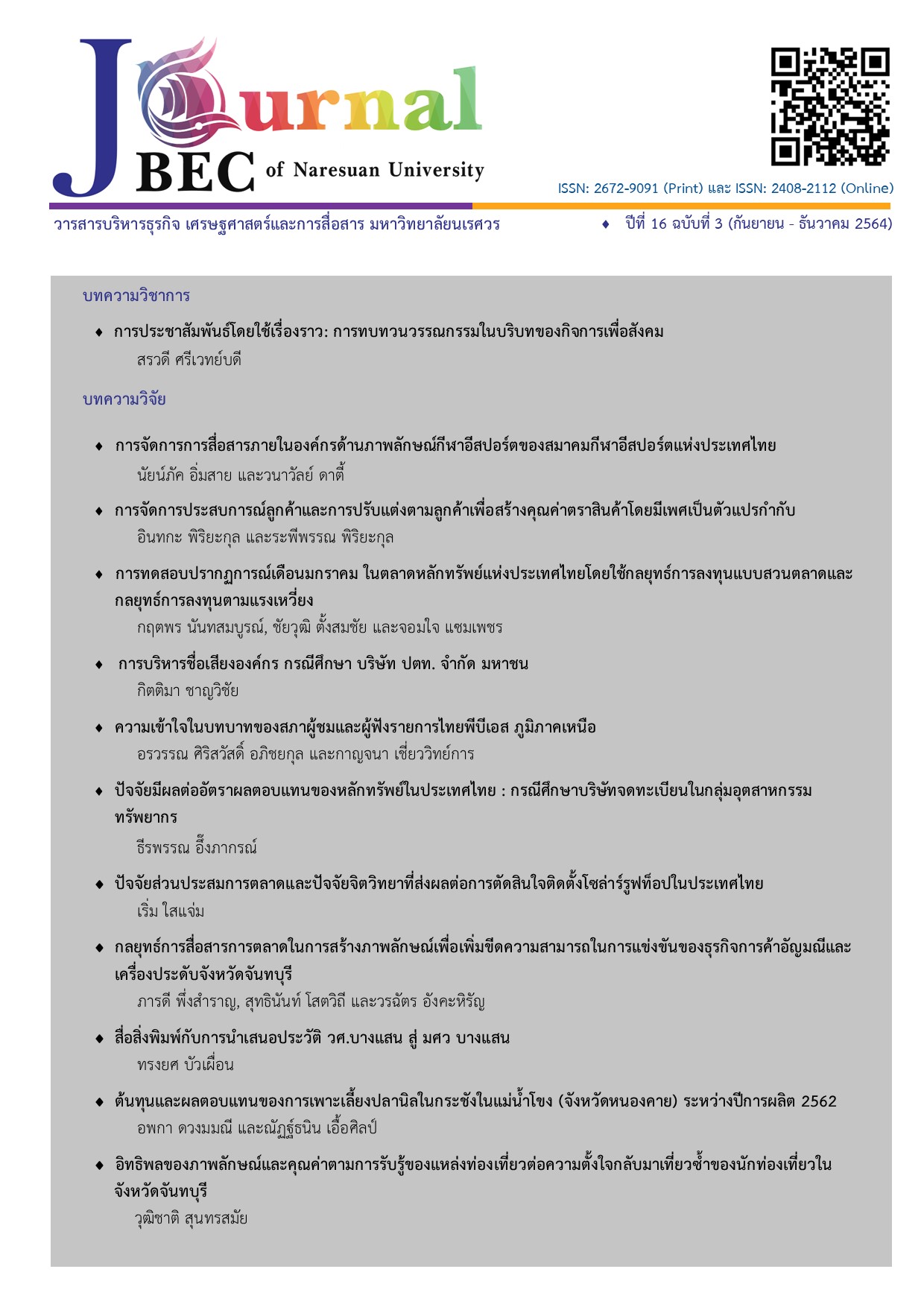ปัจจัยที่มีผลต่ออัตราผลตอบแทนของหลักทรัพย์ในประเทศไทย : กรณีศึกษาบริษัทจดทะเบียนในกลุ่มอุตสาหกรรมทรัพยากร
Main Article Content
บทคัดย่อ
วิจัยนี้ศึกษาปัจจัยที่มีผลต่ออัตราผลตอบแทนของหลักทรัพย์ในกลุ่มอุตสาหกรรมทรัพยากรโดยพิจารณาปัจจัย 5 ประการได้แก่ ความเสี่ยงจากตลาด ขนาดของกิจการ มูลค่าบัญชีต่อมูลค่าตลาด สภาพคล่อง และอัตราผลตอบแทนในอดีต โดยใช้อัตราผลตอบแทนเป็นรายเดือนของหลักทรัพย์กลุ่มทรัพยากรในตลาดหลักทรัพย์แห่งประเทศไทย จำนวน 49 หลักทรัพย์ ตั้งแต่เดือนมกราคม พ.ศ.2558 ถึง เดือนธันวาคม พ.ศ.2562 ซึ่งได้รวบรวมข้อมูลจากฐานข้อมูล SETSMART ของตลาดหลักทรัพย์แห่งประเทศไทยและใช้วิธีการวิเคราะห์การถดถอยแบบ 2 ขั้นตอนของ Fama-Macbeth ผลการศึกษาพบว่าขนาดของกิจการมีความสัมพันธ์ในทิศทางบวกกับอัตราผลตอบแทนของหลักทรัพย์อย่างมีนัยสำคัญทางสถิติ ส่วนปัจจัยอื่นอันได้แก่ ความเสี่ยงจากตลาด อัตราส่วนมูลค่าบัญชีต่อมูลค่าตลาด สภาพคล่อง และอัตราผลตอบแทนในอดีต ไม่พบความสามารถในการอธิบายอัตราผลตอบแทนของหลักทรัพย์ในกลุ่มทรัพยากรอย่างมีนัยสำคัญทางสถิติ
Article Details

อนุญาตภายใต้เงื่อนไข Creative Commons Attribution-NonCommercial-NoDerivatives 4.0 International License.
เอกสารอ้างอิง
Abadi, R. and Silva, F. (2019). Common risk factors in stock returns in the MENA region. Asian Journal of Business and Accounting, 12(2), 29–60.
Acheampong, P., Agalega, E. and Shibu, A. (2014). The effect of financial leverage and market size on stock returns on the Ghana Stock Exchange: Evidence from selected stocks in the manufacturing sector. International Journal of Financial Research, 5(1), 125-134.
Amihud, Y. and Mendelson, H. (1986). Liquidity and stock returns. Financial Analysts Journal, 42(3), 43–48.
Awirothananon, T. and Auttarat, W. (2015). A comparison between CAPM and the three-factor models in analysing stock returns. Journal of Management Sciences, 32(1), 1–17.
Bakaert, G. and Harvey, C. R. (2003). Emerging markets finance. Journal of Empirical Finance, 10(1-2), 3-55.
Banchuenvijit, W. (2016). A comparison study of the abilities of CAPM and Fama-French in estimating rates of return on energy sector securities listed on the Stock Exchange of Thailand. Journal of Humanities and Social Sciences, 36(1), 146-160
Banz, R. W. (1981). The relationship between return and market value of common stocks. Journal of Financial Economics, 9(1), 3–18.
Black, F. (1972). Capital market equilibrium with restricted borrowing. The Journal of Business, 45(3), 444–455.
Brigham, E. F. and Houston, J. F. (2007). Essentials of Financial Management (2nd ed.). Singapore: Cengage.
Carhart, M. M. (1997). On persistence in mutual fund performance. The Journal of Finance, 52(1), 57–82.
Chan, L. K. C., Hamao, Y. and Lakonishok, J. (1991). Fundamentals and stock returns in Japan. The Journal of Finance, 46(5), 1739–1764.
Chou, P. H., Ho, P. H. and Ko, K. C. (2012). Do industries matter in explaining stock returns and asset-pricing anomalies? Journal of Banking & Finance, 36(2), 355–370.
Claessens, S., Dasgupta, S. and Glen, J. (1995). Return behavior in emerging stock markets. The World Bank Economic Review, 9(1), 131–151.
Cuthbertson, K. and Nitzsche, D. (2004). Quantitative financial economics: Stocks, bonds and foreign exchange (2nd ed.). London: John Wiley and Sons.
Datar, V. T., Narayan, N. Y. and Radcliffe, R. (1998). Liquidity and stock returns: An alternative test. Journal of Financial Markets, 1(2), 203–219.
Energy Absolute. (2020). Risk Factors. Retrieved July 17, 2020, from http://market.sec.or.th/public/ipos/IPOSGetFile.aspx?TransID=71696&TransFileSeq=9
Fama, E. F. and MacBeth, J. D. (1973). Risk, return, and equilibrium: Empirical tests. Journal of Political Economy, 81(3), 607–636.
Fama, E. F. and French, K. R. (1992). The cross-section of expected stock returns. The Journal of Finance, 47(2), 427–65.
Fama, E. F. and French, K. R. (1993). Common risk factors in the returns on stocks and bonds. Journal of Financial Economics, 33(1), 3–56.
Fama, E. F. and French, K. R. (2015). A five-factor asset pricing model. Journal of Financial Economics, 116(1), 1–22.
Fama, E. F. and French, K. R. (2018). Choosing factors. Journal of Financial Economics, 128(2), 234–252.
Hahn, J. and Yoon, H. (2016). Determinants of the cross-sectional stock returns in Korea: Evaluating recent empirical evidence. Pacific-Basin Finance Journal, 38, 88–106.
Heaney, R., Koh, S. and Lan, Y. (2016). Australian firm characteristics and the cross-section variation in equity returns. Pacific-Basin Finance Journal, 37, 104–115.
Hou, K., Karolyi, G. A. and Kho, B. C. (2011). What factors drive global stock returns? Review of Financial Studies, 24(8), 2527–2574.
Hou, K., Xue, C. and Zhang, L. (2015). Digesting anomalies: An investment approach. Review of Financial Studies, 28(3), 650–705.
Hung, D. N., Ha, H. T. V., and Bing, D. T. (2018). Impact of accounting information on financial statements to the stock price of the energy enterprises listed on Vietnam’s stock market. International Journal of Energy Economics and Policy, 8(2), 1–6.
Jegadeesh, N. and Titman, S. (1993). Returns to buying winners and selling losers: Implications for stock market efficiency. The Journal of Finance, 48(1), 65–91.
Keene, M. A. and Peterson, D. R. (2007). The importance of liquidity as a factor in asset pricing. Journal of Financial Research, 30(1), 91–109.
Lam, K. S. K. (2002). The Relationship between size, book-to-market equity ratio, earnings–price ratio, and return for the Hong Kong Stock Market. Global Finance Journal, 13(2), 163–179.
Lewellen, J., Nagel, S. and Shanken, J. A. (2010). A skeptical appraisal of asset-pricing tests. Journal of Financial Economics, 96(2), 175-194.
Lintner, J. (1965). Security prices, risk, and maximal gains from diversification. The Journal of Finance, 20(4), 587–615.
Martins, C. C. and Eid, W. (2015). Pricing assets with Fama and French 5-factor model: A Brazilian market novelty. In Conference: 150 Encontro Brasileiro de Finanças.
Moskowitz, T. J. and Grinblatt, M. (1999) Do industries explain momentum? The Journal of Finance, 54(4), 1249-1290.
Mukherji, S., Dhatt, M. S. and Kim, Y. H. (1997). A fundamental analysis of Korean stock returns. Financial Analysts Journal, 53(3), 75–80.
Perez, G. A. (2017). Company size effect in the stock market of Thailand. International Journal of Financial Research, 8(3), 105–110.
Roll, R. and Ross, S. A. (1980). An empirical investigation of the arbitrage pricing theory. The Journal of Finance, 35(5), 1073–1103.
SET. (2020). Market statistics. Retrieved June 10, 2020, from https://www.set.or.th/th/market/market_statistics.html
Sharpe, W. F. (1964). Capital asset prices: A theory of market equilibrium under conditions of risk. The Journal of Finance, 19(3), 425–442.
Siriworakul, M. and Tangsomchai, C. (2017). Relationship between liquidity and SET100 index stock returns and the Stock Exchange of Thailand. Payap University Journal, 27(2). 99-113.
Wang, F. and Xu, Y. (2004). What determines Chinese stock returns? Financial Analysts Journal, 60(6), 65–77.


